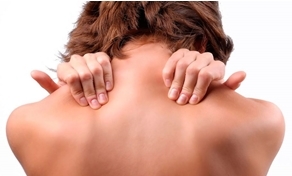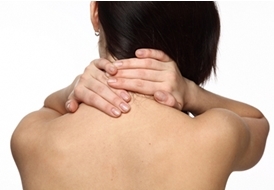
Osteochondrosis is a disease of the locomotor system. According to statistics, about 90% of the population suffers from it. The majority of patients are not even aware of this because the initial forms of the disease develop asymptomatically.
Another part of people only feels discomfort in the back intermittently, describes it as fatigue, and is not treated. Of all the types of osteochondrosis, cervical spine defeat prevails. If treatment is started on time, there is every chance of getting rid of the disease.
The essence of osteochondrosis
Two mechanisms are involved in the development of osteochondrosis: dystrophic and degenerative. The first is a violation of the trophism (nutrition) of the intervertebral cartilage (plates). The second is a consequence of dystrophy - organic changes in the structure of cartilage and vertebrae.
The essence of the disease is that circulatory disorders in certain areas of the back lead to depletion and dehydration of the cartilage tissue. Along with the fluid, it loses its nutrients. As a result, the cartilage loses its elasticity and strength - it sags. The distance between the vertebrae decreases, their staticity is damaged (stability of the situation). They can move and nest against each other while squeezing the nerve roots.
In osteochondrosis, cartilage wears out at an accelerated rate.
If dystrophy persists, the muscles that support the spine will also lose their tone. The vertebrae sag even more. As a result of the increased friction, protrusions develop - damage to the cartilage capsule as its contents protrude outwards.
The natural defense mechanism of the spine is then triggered. Bone growths appear on it - osteophytes. They must ensure a stable position of the vertebrae. However, the growth of osteophytes often exceeds the "need. "Excessive growth puts pressure on the remnants of cartilage and nerve fibers. In fact, they are solid. The spine loses its elasticity, and "adjacent discs" can be damaged. The patient loses mobility and suffers from severe pain. Advanced osteochondrosis results in disability.
Due to blood clogging, osteochondrosis is accompanied by the deposition of salts in adjacent areas of cartilage. Such "accumulations" exacerbate the development of the disease, accelerating damage to cartilage and vertebrae.
Why the neck is injured more often
The cervical spine is the most sensitive and fragile. Its elements are the smallest and do not adapt to high loads. However, the neck muscles are not involved in any kind of physical activity. Therefore, chronic congestion and malnutrition of the vertebral joints. If a person does not exercise, the risk of osteochondrosis of the neck increases significantly. Most people very rarely use their necks for everyday tasks.
The main cause of osteochondrosis is a hypodynamic lifestyle. Lack of exercise combined with passive leisure leads to muscle weakness and vascular disorders. Neck disease triggers a long stay in a situation. Osteochondrosis of the cervical spine is considered by many office workers and IT professionals.
Excessive physical activity leads to muscle hypertension. They also trigger stagnant processes in a state of constant tension. Indirect causes of the disease include malnutrition (excess salt and fat in the diet), metabolic disorders. The disease can be triggered by autoimmune processes, lack of nutrients (vitamins and minerals), endocrine disorders, and psychoemic shocks (as they also involve muscle strain).
How is cervical osteochondrosis recognized?

Early osteochondrosis does not manifest in any way. In stage 1 of development, the cartilage dries out. Unobtrusive from the outside, does not cause physical discomfort. The disease can be accidentally discovered when the spine is examined for injuries or other complaints.
In stage 2, the cartilage sags. Its height decreases and its damping ability deteriorates. Early symptoms may appear at this stage. They are characterized by periodicity. The discomfort in the neck is clearly felt and then subsides. Sometimes it disappears completely. A person sometimes feels pain in the neck. They appear after physical exertion or a long stay in a position (sitting or standing). Uncomfortable feelings occur in the morning when the patient "walks", weakens, and reminds themselves in the late afternoon. If salts are deposited in the cervix, the person will hear a crack in the spine when they turn around. When you tilt your head, "clicking" doesn't hurt.
In stage 3, the nerve roots can be partially captured. This is accompanied by severe painful feelings. Patients complain of lumbago and sudden sudden pain in the neck. The discomfort occurs after a static situation. He is more often concerned about the early stages. The man's neck "gets tired" in a short time. There may also be painful pains. They attack the patient in the evening and at night.
Stagnation of the cervical spine leads to cerebrovascular accident. Headache (sometimes migraine), tinnitus, dizziness. In case of persistent lack of oxygen (lack of oxygen), a feeling of "goose hills" occurs on the scalp, often on one side. There are also secondary symptoms - the patient gets tired quickly, feels weak, sleepy (for no reason at all), sometimes sleep disturbed.
The mobility of the joints in the cervical spine changes in parallel with the listed symptoms. Some head or neck movements are accompanied by sharp pain. The patient subconsciously reduces his amplitude, trying to maintain a comfortable position.
Stage 4 osteochondrosis is accompanied by protrusions and the appearance of osteophytes. A violation of the nerve roots that leads to persistent pain syndrome. When inflammation develops in the process of change, the pain becomes permanent. A person has more and more headaches, vision impairments (vision impairment at dusk, “flies”, blurred image). Neck mobility is significantly limited. The patient avoids turning the neck, if necessary, turning the whole body. Nerve damage results in pain, "goosebumps, " or numbness in the shoulder blades, shoulders, forearms, and even hands.
Diagnostics

The above complaints should be directed to a neurologist, orthopedist, or vertebrologist. The doctor listens to the patient and performs an examination. During the examination, you will check the sensitivity of the points, reflexes and mobility of the cervical spine. If osteochondrosis is suspected, further investigation is required. X-rays of the cervical spine are included in several projections.
If there are no abnormalities on the x-ray, but the patient still has complaints, an MRI or CT scan is prescribed. With these methods, osteochondrosis can be detected even in the earliest stages.
How to handle
Even if the patient has all the signs of osteochondrosis, it is better to see a doctor. Only a specialist will be able to objectively assess the extent of death, distinguish chondrosis from other diseases, make the correct diagnosis, and individually select a treatment regimen.
This disease takes a long time to develop. Exacerbation of osteochondrosis may occur periodically and resolve on its own. The patient should continue to be examined.
The disease is treated on an outpatient basis. Surgical intervention (to remove osteophytes) is an emergency measure that is only used in cases of severe damage to the nerve roots with severe pain syndrome. Conservative treatment can almost always be dispensed with.
Osteochondrosis (depending on the stage) is treated for 1-3 months. Therapy should be comprehensive. Medications alone are essential. Even after the onset of improvement, the patient should monitor his or her activities and take preventive measures. The main task of treatment is to stop the degenerative processes. Medication relief of symptoms only relieves the patient's condition for a period of time. There are many ways to treat osteochondrosis at home.
Drug therapy
Medications can help eliminate inflammation, relieve pain, provide the body with useful substances, and improve the nutrition of the cartilage in the cervical spine. Painkillers are used as symptomatic treatment. In the inflammatory process, pain is relieved with the help of NSAIDs. Medicines are prescribed in the form of tablets (if the symptoms are mild) or in the form of injections (if the pain is severe).
Muscle relaxants are prescribed in parallel with NSAIDs to eliminate muscle hypertension. These funds enhance the effect of painkillers by ensuring their "free access" to the inflammatory focus. Painkillers are used for as short a time as possible (5-10 days) due to the risk of side effects.
Chondroprotectors are prescribed to increase flexibility and restore cartilage. In the acute period, these are injections. As maintenance therapy, doctors recommend long-term (3-6 months) administration of capsules or tablets.
To increase the effectiveness of the treatment, the tablets can be combined with external agents (ointments, gels, patches). Pepper or menthol patches, ointment painkillers relieve severe pain. Osteochondrosis can also be treated with chondroprotective ointments.
B vitamins and vascular preparations are prescribed to improve joint trophism.
Folk remedies

There are many suggestions for treating osteochondrosis in traditional medicine recipes. Like the traditional approach, folk remedies can be applied internally or externally.
Strongest current mixes:
- Horseradish compression.The horseradish root is rubbed on a fine grater, the bag is spread on gauze, smeared on the neck, covered with a film, wrapped in bandage, left for 2 hours, washed with clean water, the procedure is performed 10 days in a row before going to bed.
- Compact with potatoes.Rub 3 large potatoes, add 1 tablespoon honey and 1 tablespoon mustard, lubricate the mixture on the cheesecloth and fix for 1 hour on the sore area, cover with a compress 2 times a day for 2 weeks.
- Red pepper creams.Crush 2 pods of hot red pepper into a crumb, mix with chopped aloe leaves, pour a glass of alcohol, a day later moisten the mixture with gauze, apply on the neck for 15-20 minutes, wash with cool water. The treatment lasts for 2 weeks.
Compression with mustard and pepper is good to increase blood circulation.
Inside you can make infusions, decoctions and tinctures. All recipes are aimed at normalizing metabolism, removing salts, eliminating inflammation:
- Parsley soup.Grind 3 tablespoons of parsley seeds in a coffee grinder. Pour the mass with a liter of boiling water, simmer for 10-15 minutes. After complete cooling, filter. Orally 100 ml twice a day for 15 days.
- Barberry tincture.Pour a mixture of 10 g of dried root and barberry bark (available at a pharmacy or from herbalists) with 100 ml of alcohol or vodka. The mixture is placed in a dark place for 10 days. After exertion, 30 drops should be taken orally three times a day, half an hour before a meal.
- Celery infusion.Pour a tablespoon of grated celery root with a liter of water. Bring to a boil over low heat, turn off immediately. After a day, strain, take 3 tablespoons three times daily before meals. The treatment lasts for 1 month.
Before using traditional medicines, make sure you are not allergic to their ingredients. If a strong burning sensation occurs during compression, you should remove the bandage and rinse the remaining mixture with running water.
Physiotherapy, exercise and massage

Doctors often prescribe physiotherapy to treat osteochondrosis. This can be warming up with medical ultraviolet light, exposure to low frequency currents, magnetotherapy, electrophoresis or phonophoresis. Such manipulations are performed in a hospital using special tools. They eliminate inflammation and improve drug access to cartilage tissue. The combination of medication and physical therapy quickly relieves unpleasant symptoms. The course requires 10-15 procedures. To achieve a stable result, all types of physiotherapy should be completely discontinued (do not interrupt).
Physiotherapy involves simple exercises to treat cervical osteochondrosis. They can be done independently in the morning and evening, as well as between work. Physical education can be done sitting or standing.
The following exercises can be incorporated into the treatment of cervical osteochondrosis:
- Rotate your head clockwise for 2 minutes, then counterclockwise (then 2 sets);
- Smoothly lower your head forward, backward and sideways (15 times in each direction);
- raise your shoulders as high as possible, leaving your neck and head motionless (15-20 times);
- rotate your shoulders forward or backward while keeping your neck and head motionless (1 minute in both directions);
- fold your palms, press your fingers in the middle of the forehead, smoothly passing the temporal regions along the neck to the clavicles (10 times);
- without changing the position of the chin, smoothly take back the neck (retract your chin) and then forward, to the side (without tilting or turning your face);
- Gather your palms in a lock behind your back, pull your arms back, raise and stretch your neck as high as possible, stay in an extended position for 15 seconds (three times).
In osteochondrosis, massage is considered to be the best way to improve neck blood circulation. It is better for the patient to take a full course (10-15 sessions) with a trained professional. If this is not possible, you can knead your neck at home.
Self-Massage Quick Guide:
- first warm the neck muscles: rub the back of the head with the pads of the fingers or the edge of the palm; kneading
- involves soft pressing followed by muscle relaxation - kneading with 4 collected pads and thumb;
- Slightly tighten the skin of the neck to improve blood circulation;
- travel through the neck region with light fingers on both sides of the spine;
- To loosen the headrest, gently stroke your palm or fingers.
Each phase of the massage ends with a slight palm stroke. To improve the effect, the neck is massaged with an ointment. After the massage, you need to make sure that the neck region is warm.
Massage your neck only with your palm or fingertip (not your fist).

All methods of treating osteochondrosis should be supplemented with diet. A classic healthy diet includes the use of lean meats, fish, seafood, whole grains and lots of vegetables. Food should be cooked, baked or steamed.
You need to reduce your salt intake, give up fast food and sweets throughout your diet. It is important to drink at least 1, 5 liters of water per day. It is useful to eat gels and jellies to strengthen the joints.
With an integrated approach, the symptoms of the disease disappear within a week and the destruction of cartilage stops completely.



































